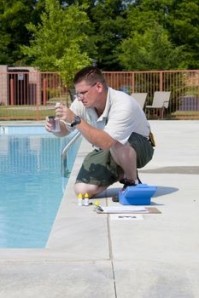 “…Many of the outbreaks related to swimming pools would have been prevented or reduced if the pool had been well managed….”
“…Many of the outbreaks related to swimming pools would have been prevented or reduced if the pool had been well managed….”
“….these challenges can be met through a combination of the following factors:
- treatment (to remove particulates, pollutants and microorganisms), including filtration and disinfection (to remove/inactivate infectious microorganisms);
- pool hydraulics (to ensure effective distribution of disinfectant throughout the pool, good mixing and removal of contaminated water);
- addition of fresh water at frequent intervals (to dilute substances that cannot be removed from the water by treatment);
- cleaning (to remove biofilms from surfaces, sediments from the pool floor and particulates adsorbed to filter materials);
- and ventilation of indoor pools (to remove volatile disinfection by-products and radon).
(From a FreeDrinkingWater.com article)Â Controlling clarity, the most important water quality criterion, involves adequate water treatment, including filtration. The control of pathogens is typically achieved by a combination of circulation of pool water through treatment (normally requiring some form of filtration plus disinfection) and the application of a chemical residual disinfectant to inactivate microorganisms introduced to the pool itself by, for instance, bathers. As not all infectious agents are killed by the most frequently used residual disinfectants, and as circulation through the physical treatment processes is slow, it is necessary to minimize accidental faecal releases and vomit (and to respond effectively to them when they occur) and to minimize the introduction of bather-shed organisms by pre-swim hygiene.



